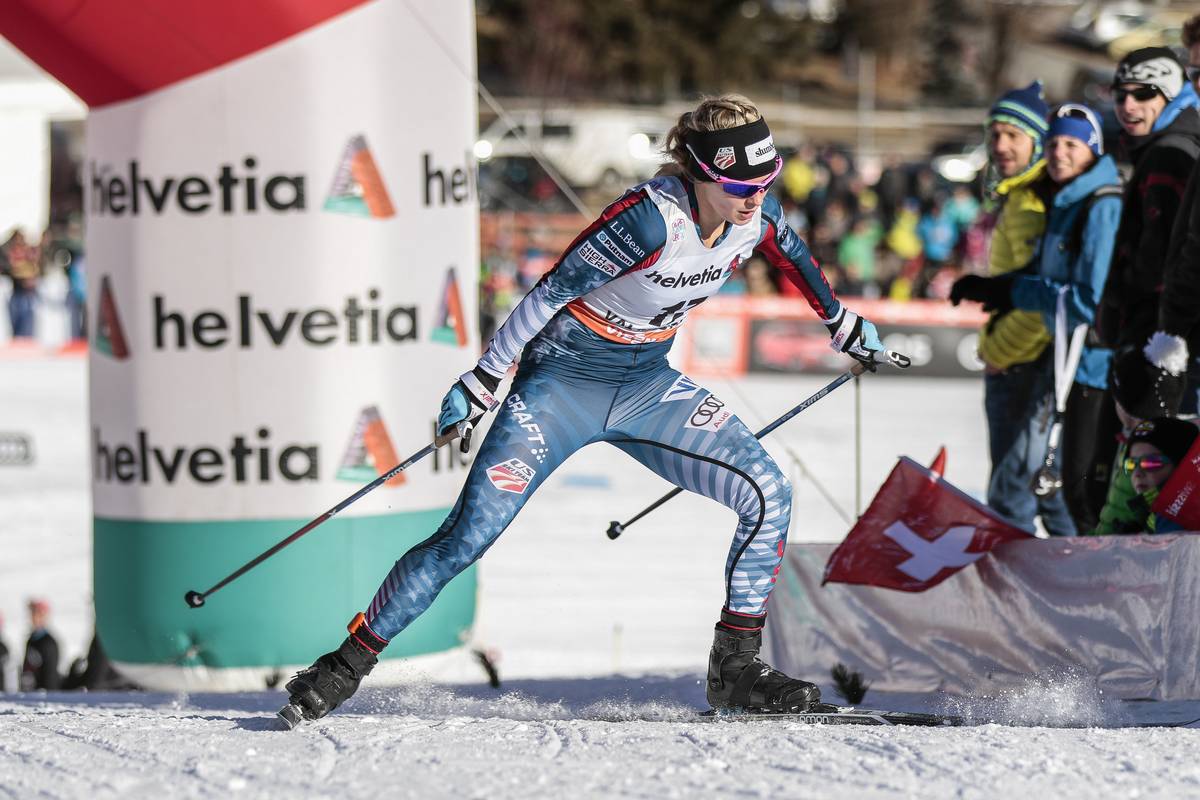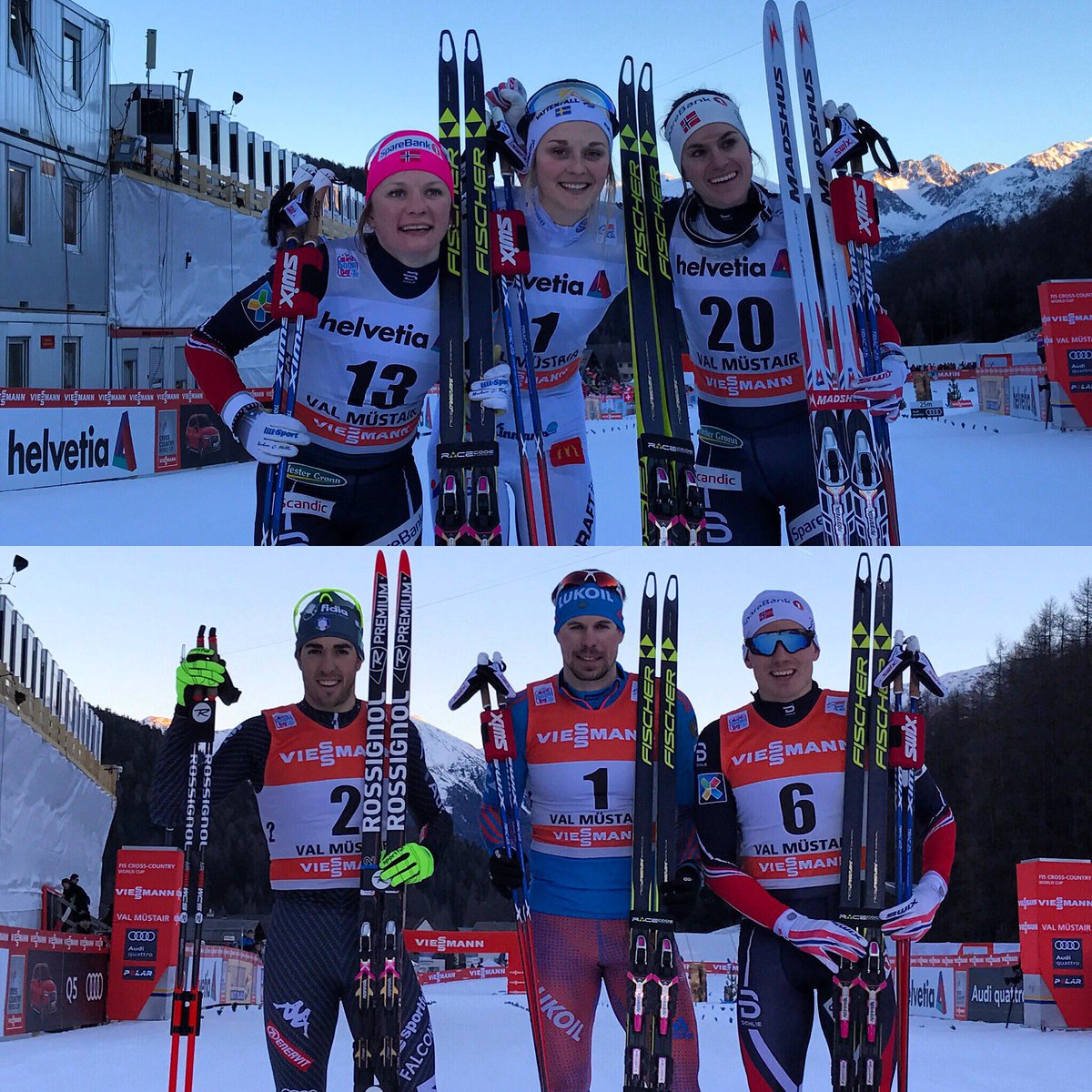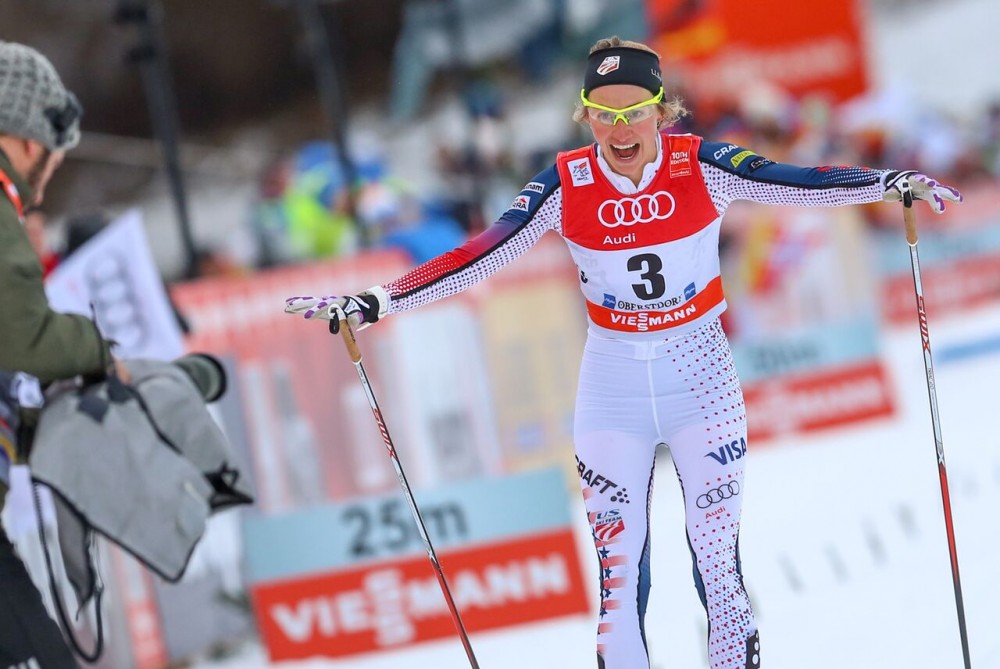
As the women’s sprint finalists promenaded through the stadium toward the starting pen, the demeanors caught on camera varied, seemingly a reflection of their differing personalities or emotions at that moment.
On one hand, there was Stina Nilsson, Sweden’s sprint queen, walking through the athlete’s chute at the first stage of the Tour de Ski with the body language of a prizefighter.
Then there was Norway’s Maiken Caspersen Falla, more smiley and cheery than Nilsson, her fiercest sprint rival on the World Cup circuit. Heading into Saturday’s freestyle sprint, the last eight sprint wins had gone to either Nilsson or Falla. According to the International Ski Federation (FIS), that’s the longest streak ever between two athletes in a sprint.
Next came Switzerland’s Laurien van der Graaff, more reserved in front of her home crowd in Val Müstair, Switzerland, and Norway’s Kathrine Rolsted Harsem, who looked simply happy to be there in her first World Cup of the season.
And then there was Jessie Diggins, the well-known, fun-loving American, exuding the most energy of anyone heading to the start with her head held high as she looked out at the arena.
Finally, Norway’s Heidi Weng shuffled down the line, looking down and avoiding eye contact as she passed the TV camera. But she should get a pass on her body language; she suffered food poisoning before the race, according to Norwegian reports.
As all six women lined up at the start for their formal introductions, Diggins waved with bare hands. On an afternoon with temperatures hovering around freezing, she wasn’t trying to be tougher than everyone else, Diggins later explained.
“That was actually a mistake,” she said in a phone interview. “I was so excited and ready to go, and they were like, ‘All right, march in for the final,’ and I was like, ‘Great, I’m ready.’ ”
With her skis in hand, Diggins began her entrance before realizing she was still wearing her lobster mitts. It had been getting colder as the day entered the evening, and she had switched to the quasi-mitten before the final.
“I got over there, and realized I was still wearing my lobster gloves, and I was like, ‘Oh crap! I don’t want to race with these on!’ ” she said.
She decided she’d be better off racing with bare hands.
“I love my race gloves. I wish I had remembered them, but I didn’t,” Diggins said.
Two laps, 1.5 kilometers and nearly 3 1/2 minutes later, Diggins crossed the line in sixth, but it wasn’t so much an issue of no gloves as it was her positioning.
“I needed a better start to get in a good position from the gun, but that’s fine,” she reflected. “It’s a long tour, and I would just like to be in the final.”
Diggins finished 7.64 seconds behind Nilsson, who won in 3:26.27 to rebound from 31st place in the last skate sprint three weeks ago in Davos, Switzerland, for her second win of the season.

“This was really important to me since Davos didn’t go so well,” the 23-year-old Nilsson said in a televised interview with TV2. “I am really happy. I felt strong through the entire day.”
“She was in a league of her own,” Swedish women’s coach Ole Morten Iversen told Expressen.
“I’m not surprised that she won, but I am a little surprised by how strong she was compared to the Norwegians. She was on a different level the entire day.”
Nilsson won the qualifier by 1.28 seconds (in 3:28.28) then proceeded to pull away from her competition in the quarterfinal and semifinal, which she won by roughly half a second and one second, respectively. (Diggins finished second behind her in the quarterfinal, after Diggins led the early in the heat. Nilsson passed her the course’s biggest climb on the first lap, while Diggins chased in second all the way to the finish.)
In the semifinal, Diggins and Nilsson met again, with Nilsson leading out of the start and Diggins following in second into the first climb. Falla eventually passed Diggins to move into second while Nilsson continued to lead, then the two built a small gap on Diggins in third. They finished in that order, with Nilsson holding off Falla by 1.04 seconds and Diggins by 1.36 seconds, in first, second and third, respectively.
In the final, Nilsson once again set the tone out of the start, leading Weng and Falla into the stadium at the end of the first lap. Diggins slipped to the back of the field on the first climb then fought to pass van der Graaff on the final descent.
Meanwhile, Nilsson and Falla distanced themselves from Weng in third place, who was just ahead of her Norwegian teammate Harsem in fourth.
Nilsson led into the finishing straight, several strides ahead of Falla, while Falla chased her across the line for second place, about 2 1/2 seconds back. Weng held off Harsem and van der Graaff by half a second for the third spot on the podium, 6.47 seconds out of first, Harsem placed fourth, and the Swiss skier outlasted Diggins by 0.68 seconds for fifth (+6.96).
“This is the worst thing I’ve ever been part of,” Weng said of racing after her food-poisoning episode in an interview with NRK. “… I just had to get it together. The prologue felt heavy, the quarter was heavy, the semi was heavy and the final was heavy. I had to try think positive, that everyone else was tired, but it was hard.”
For Harsem, 27, she was emotional about making it to the final after considering retiring before the start of this season.
“.. There were a lot of emotions in system and it was just so incredibly fun to be successful,” she told NRK. “I tried to wipe my tears and mobilize all that I had. I realized that I could. I had planned to go easy on the first lap, and then Heidi and I weren’t attentive enough to follow Stina and Maiken.”
Even Falla called it a long, hard race, and told FIS she had expected Weng to keep up with Nilsson.
“In the second lap of the final Heidi got little bit tired and I tried to close the gap on Stina myself,” Falla said. “I did not have enough power to do that. Stina was in a great shape.”
While Nilsson has a 10.7-second lead on Falla heading into the second stage of the Tour, it’s worth noting that this is the only sprint on the seven-stage schedule.
“I’m proud to say that I have the lead in the Tour de Ski, I’m going to enjoy this,” Nilsson told Expressen.
Diggins was also onboard with living in the moment.
“My goal for the Tour is have more fun than anyone else, because when I’m having fun that’s when I’m the most dangerous on the race course, and that’s when I’m going fast,” she said. “Yeah, it’s my job, and you always want to win, but it’s also my life, and I want to enjoy the Tour because it’s a really exciting and fun event.
“Going into the final already had my strategy worked out,” she added. “… I’m going to go out there and ski as hard as I can. I’m going to focus on what I need to do, but I’m going to enjoy myself. My game face is not an intimidating one.”
“My goal for the Tour is have more fun than anyone else, because when I’m having fun that’s when I’m the most dangerous on the race course, and that’s when I’m going fast.” — Jessie Diggins, U.S. Ski Team
Sunday’s race is a 5 k classic mass start, so the top women in the Tour so far will line up alongside one another at the front of the pack. That’s a good thing for someone like Diggins, who is currently sixth in the Tour and 23.7 seconds out of first. But she didn’t think it was necessarily fair and noted that it will be tough to pass on the Val Müstair course, just as it was on Saturday’s technical sprint course.
“I think it’s mildly hilarious that we’re doing a 5 k classic mass start,” Diggins said. “I think it’s so stupid that the women have to do exactly half the distance the men do all the time. I think that it’s silly. I think we can handle more.
“That said, I love 5 k’s, I just think a 5 k mass start isn’t entirely fair to the people who are starting in the back; that sucks for them,” she continued. “It will be a fun course tomorrow; it’s a grind of a climb up, and then there’s a lot of 90-degree corners and sharp downhills. There’s one that’s like an elevator shaft. It’s going to be really exciting.”

Diggins led four U.S. women in the top 30 on Saturday, more specifically in the top 23. Sophie Caldwell qualified fifth, 3.15 seconds behind Nilsson, for her best qualifier in nearly a year (since qualifying third in last year’s Tour de Ski classic sprint in Oberstdorf, Germany, which Caldwell went on to win).
Sadie Bjornsen qualified eighth (+5.08), and Diggins was the third U.S. woman qualifying in the top 10 in ninth (+5.64).
“We expected big things today, and I think we had certainly a good day to prove that that was in fact the case, and that the tour should go well for us,” U.S. Ski Team Women’s Coach Matt Whitcomb said on the phone.
Kikkan Randall also qualified in 29th (+10.77) on her 34th birthday for her first individual top 30 of the season.
“It was a very difficult course, aerobically as well as technically,” Whitcomb explained. “At 1,600 meters [above sea level], there’s a lot of climbing. To have our women do as well as they did, including Kikkan on her birthday getting into the heats, just said straight up that we’ve got fast women. They’re in good shape, they’re ready for big results, whether or not that happens individually today, or not, that’s just sprint racing.”
Caldwell went on to place 13th after finishing third in her quarterfinal, 0.72 seconds behind Finland’s Krista Parmakoski in first. Slovenia’s Vesna Fabjan automatically advanced to the semifinals in second, 0.71 seconds back, just one-hundredth of a second ahead of Caldwell.
“I was happy with the qualifier and feel so-so about the overall result,” Caldwell wrote in an email. “It was not my best race, but it was not my worst, it was solid.”
She plans to race the second stage on Sunday then withdraw from the Tour for a training block before the next set of regular-season World Cup sprints in Toblach, Italy.
“I got hit hard with the cold that was going around our team as soon as I started Christmas break, so I had to take some time off and do some walking pace training,” Caldwell explained. “I did a little threshold yesterday, but that was my first intensity since La Clusaz [two weeks ago], so I wasn’t sure what to expect going into today. I’m happy to be feeling healthy again, though.
“It’s a long season and while I haven’t had the races I want to have yet, I’m confident that with some consistent training and resting, I can keep getting faster,” she added.
Randall finished third in her quarterfinal, 1.42 seconds behind Falla in first and 0.46 seconds after Germany’s Hanna Kolb in second.
“Today definitely felt like another step forward toward getting my race sharpness back,” Randall wrote in an email to members of the press. “My qualifier was decent and I felt like I had more punch in my quarterfinal. Tough to just miss the lucky loser spot because I was feeling stronger as I went and actually felt competitive for the first time this season. Still lots of racing ahead though so I am satisfied with today as a good start and am feeling good about the races ahead.”
As for how she’d celebrate her birthday and the new year, Randall wrote that it would be a tame night.
“Pop some confetti for us this evening, we’ll probably be in bed early for tomorrow’s race,” she wrote.
Bjornsen explained in an email that she was also hit with the bug and hadn’t skied at sprint pace since Davos three weekends ago. Like Diggins, she did not race in La Clusaz.
“I didn’t know what to expect,” she said of the qualifier. “I felt like I paced it well, but I was an early starter, so I didn’t know what to expect. I was really pleased to see how it had gone.”
Like Caldwell, Bjornsen pushed to get in front early in her quarterfinal on Saturday, but while Caldwell came from behind for third place at the finish, Bjornsen managed to hold the lead into the finishing straight. But in the final meters, something happened. Bjornsen lost her momentum and slipped to fifth.
“I noticed that someone was skiing over my pole almost the entire race,” Bjornsen wrote of the possibility of someone stepping on her pole before the finish. “I don’t recall much from the finish zone other than the fact that I really wanted to get to that line. At one point I bobbled and lost my balance… not sure why… but that was real game changer.”
She ended up 0.78 seconds out of first, which went to van der Graaff.
“I have began to realize this fall that my strength is over the whole course,” Bjornsen explained. “I have made a mistake in the last couple sprint races to sit in the pack, and expect a sprint finish, but I haven’t had so much luck with that. The best I ski is when I am in control a bit. I had a plan to try to be in the front, and it worked out as I was hoping. Of course you run the risk of working harder, but I think that is ok for me. I wasn’t strong enough in the finish zone, and I bobbled, which really was a bummer.
“There are glimmers in today, and I think that I learned that I am strong enough to ski in command,” she added. “I just need to figure out that finish stretch … but fortunately I have seven more races rather quickly in a row to get some redemption with.”
“There were a number of thirds and fourths out there for us today in heats,” Whitcomb noted. “In stand-alone races, we can kind of just look at those and say, ah, I wish that lunge had gone a little better, but in a tour we really have to be glass half-full. We had three girls in the top 15, four people total in the top 20. It’s a really positive start to the team, it’s just a great, solid day.”
Also for the U.S., Rosie Brennan finished 35th, 2.66 seconds outside the top 30, and Liz Stephen placed 57th in the qualifier.
“Liz was sick for a couple days coming into the tour, and just today she was feeling better and she was actually our last person to kind of have this illness,” Whitcomb explained. “As long as today was accepted by her body, we are operating with a completely healthy team going into tomorrow.”
“The tour has always been a fun event for us,” Diggins said. “We see it as you have a chance today and a chance tomorrow, you have all these chances to go out and kick some butt, and I think people are really embracing that. If you had the race you wanted today; awesome, and if you didn’t, you’ll have it tomorrow.”
Results: Sprint qualifier | Heats | Tour standings (through Stage 1)
Alex Kochon
Alex Kochon (alexkochon@gmail.com) is a former FasterSkier editor and roving reporter who never really lost touch with the nordic scene. A freelance writer, editor, and outdoor-loving mom of two, she lives in northeastern New York and enjoys adventuring in the Adirondacks. She shares her passion for sports and recreation as the co-founder of "Ride On! Mountain Bike Trail Guide" and a sales and content contributor at Curated.com. When she's not skiing or chasing her kids around, Alex assists authors as a production and marketing coordinator for iPub Global Connection.



